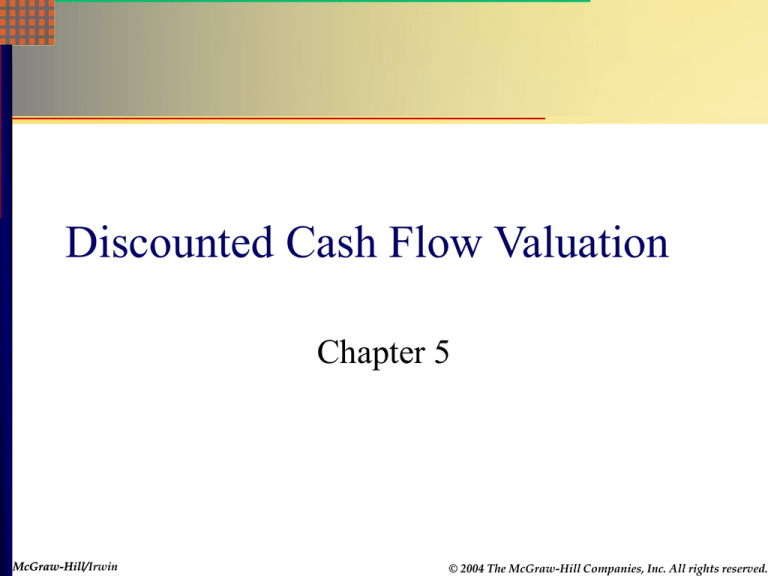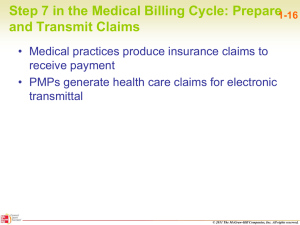
Discounted Cash Flow Valuation
Chapter 5
McGraw-Hill
McGraw-Hill/Irwin
© 2004 The McGraw-Hill Companies, Inc. All rights reserved.
Chapter Outline
1.
2.
3.
4.
Future and Present Values of Multiple Cash
Flows
Valuing Level Cash Flows: Annuities and
Perpetuities
APR and EAR
Different Types of Loans
5.1
McGraw-Hill
McGraw-Hill/Irwin
© 2004 The McGraw-Hill Companies, Inc. All rights reserved.
Steps in Time Value of Money
Calculation
1.
2.
3.
4.
5.
Draw the time line;
Identify the problem: is it a single cash flow, annuity,
or perpetuity problem?
Clarify the question: is it asking for PV, FV, periodic
payment, etc?
Find out the right formula or the right keys on the
calculator;
Double check how frequently the interest is earned,
and make sure the number of period matches with the
period rate.
5.2
McGraw-Hill
McGraw-Hill/Irwin
© 2004 The McGraw-Hill Companies, Inc. All rights reserved.
Time Value of Money Calculation
Three groups of formulas
Single cash flow: FV = PV(1 + r)t
1
Annuity:
1
PV C
(1 r ) t
r
(1 r ) t 1
FV C
r
Perpetuity:
PV = C / r
Constant growth perpetuity: PV=C1/(r-g)
5.3
McGraw-Hill
McGraw-Hill/Irwin
© 2004 The McGraw-Hill Companies, Inc. All rights reserved.
Time Value of Money Calculation
Three sets of calculator keys
Single cash flow: N, I/Y, PV, FV
Annuity: N, I/Y, PV(or FV), PMT
Combination of single cash flow and annuity for
bond evaluation: N, I/Y, PV, PMT, FV
5.4
McGraw-Hill
McGraw-Hill/Irwin
© 2004 The McGraw-Hill Companies, Inc. All rights reserved.
1. Multiple Cash Flows
– Future Value Example 1
You
think you will be able to deposit $4,000 at
the end of each of the next three years in a bank
account paying 8 percent interest. You currently
have $7,000 in the account. How much will you
have in three years? In four years?
7000
4000
4000
4000
0
1
2
3
4
5.5
McGraw-Hill
McGraw-Hill/Irwin
© 2004 The McGraw-Hill Companies, Inc. All rights reserved.
Multiple Cash Flows
– Approaches to find FV in Year 4
7000
4000
4000
4000
0
1
2
3
4
5.6
McGraw-Hill
McGraw-Hill/Irwin
© 2004 The McGraw-Hill Companies, Inc. All rights reserved.
Multiple Cash Flows
– Approaches to find FV in Year 4
7000
4000
4000
4000
0
1
2
3
4
5.7
McGraw-Hill
McGraw-Hill/Irwin
© 2004 The McGraw-Hill Companies, Inc. All rights reserved.
Multiple Cash Flows
– FV Example 1
Find
the value at year 3 of each cash flow
and add them together.
Today (year 0): FV = 7000(1.08)3 = 8,817.98
Year 1: FV = 4,000(1.08)2 = 4,665.60
Year 2: FV = 4,000(1.08) = 4,320
Year 3: value = 4,000
Total value in 3 years = 8817.98 + 4665.60 + 4320 +
4000 = 21,803.58
Value
at year 4 = 21,803.58(1.08) = 23,547.87
5.8
McGraw-Hill
McGraw-Hill/Irwin
© 2004 The McGraw-Hill Companies, Inc. All rights reserved.
Multiple Cash Flows
– FV Example 2
Suppose
you plan to deposit $100 into an account
in one year and $300 into the account in three
years. How much will be in the account in five
years if the interest rate is 8%?
5.9
McGraw-Hill
McGraw-Hill/Irwin
© 2004 The McGraw-Hill Companies, Inc. All rights reserved.
Example Timeline
0
1
100
2
3
4
5
300
5.10
McGraw-Hill
McGraw-Hill/Irwin
© 2004 The McGraw-Hill Companies, Inc. All rights reserved.
Example Timeline
0
1
2
100
3
4
5
300
349.92
136.05
100(1.08)4
300(1.08)2
FV =
+
= 136.05 + 349.92 = 485.97
485.97
5.11
McGraw-Hill
McGraw-Hill/Irwin
© 2004 The McGraw-Hill Companies, Inc. All rights reserved.
Multiple Cash Flows
– Present Value Example
You
are offered an investment that will pay you
$200 in one year, $400 the next year, $600 the
next year and $800 at the end of the next year.
You can earn 12 percent on very similar
investments. What is the most you should pay for
this one?
5.12
McGraw-Hill
McGraw-Hill/Irwin
© 2004 The McGraw-Hill Companies, Inc. All rights reserved.
Example Timeline
0
1
200
2
3
4
400
600
800
178.57
318.88
427.07
508.41
1432.93
5.13
McGraw-Hill
McGraw-Hill/Irwin
© 2004 The McGraw-Hill Companies, Inc. All rights reserved.
Multiple Cash Flows
– PV Example
Find
the PV of each cash flow and add them
Year 1 CF: 200 / (1.12)1 = 178.57
Year 2 CF: 400 / (1.12)2 = 318.88
Year 3 CF: 600 / (1.12)3 = 427.07
Year 4 CF: 800 / (1.12)4 = 508.41
Total PV = 178.57 + 318.88 + 427.07 + 508.41 =
1432.93
5.14
McGraw-Hill
McGraw-Hill/Irwin
© 2004 The McGraw-Hill Companies, Inc. All rights reserved.
2. Annuities and Perpetuities
Defined
– finite series of equal payments that
occur at regular intervals
Annuity
If the first payment occurs at the end of the period, it
is called an ordinary annuity
If the first payment occurs at the beginning of the
period, it is called an annuity due
Perpetuity
– infinite series of equal payments
5.15
McGraw-Hill
McGraw-Hill/Irwin
© 2004 The McGraw-Hill Companies, Inc. All rights reserved.
Annuities and Perpetuities
Annuity
4000
4000
4000
PV
4000
FV
Annuity Due
4000
4000
4000
4000
PV-due
Perpetuity
0
PV
McGraw-Hill
McGraw-Hill/Irwin
FV-due
4000
4000
4000
4000
...
1
2
3
4
...
5.16
© 2004 The McGraw-Hill Companies, Inc. All rights reserved.
Annuities and Perpetuities – Basic
Formulas
Ordinary Annuities:
1
1 (1 r ) t
PV C
r
(1 r ) t 1
FV C
r
Perpetuity:
PV = C / r
5.17
McGraw-Hill
McGraw-Hill/Irwin
© 2004 The McGraw-Hill Companies, Inc. All rights reserved.
2.1 Ordinary Annuity: Present Value
C
C C
C
C
1
2
4
5 . . .
3
. . .
C
t
PV= C/(1+r) + C/(1+r)2 + C/(1+r)3 + …+ C/(1+r)t
PV= C[1/(1+r) + 1/(1+r)2 + 1/(1+r)3 + …+ 1/(1+r)t]
1
1
(1 r ) t
PV C
r
5.18
McGraw-Hill
McGraw-Hill/Irwin
© 2004 The McGraw-Hill Companies, Inc. All rights reserved.
Ordinary Annuity: Future Value
0
C
C C
C
C
1
2
4
5 . . .
3
. . .
C
t
FV= C(1+r)t-1+ C(1+r)t-2 + C(1+r)t-3 + …+ C
FV= C[(1+r)t-1+ (1+r)t-2 + (1+r)t-3 + …+ 1]
(1 r )t 1
FV C
r
5.19
McGraw-Hill
McGraw-Hill/Irwin
© 2004 The McGraw-Hill Companies, Inc. All rights reserved.
Annuities and the Calculator
You
can use the PMT key on the calculator for
the equal payment
The sign convention still holds
5.20
McGraw-Hill
McGraw-Hill/Irwin
© 2004 The McGraw-Hill Companies, Inc. All rights reserved.
Annuity PV – Example (5.5)
After
carefully going over your budget, you have
determined you can afford to pay $632 per month
towards a new sports car. You call up your local
bank and find out that the going rate is 1 percent
per month for 48 months. How much can you
borrow?
5.21
McGraw-Hill
McGraw-Hill/Irwin
© 2004 The McGraw-Hill Companies, Inc. All rights reserved.
Annuity PV– Example (5.5)
You
borrow money TODAY so you need to
compute the present value.
48 N; 1 I/Y; -632 PMT; CPT PV = 23,999.54
($24,000)
Formula:
1
1
(1.01) 48
PV 632
.01
23,999.54
5.22
McGraw-Hill
McGraw-Hill/Irwin
© 2004 The McGraw-Hill Companies, Inc. All rights reserved.
Annuity – Finding the Payment
Suppose you want to borrow $20,000 for a new car. You
can borrow at 8% per year, compounded monthly (8/12
= .66667% per month). If you take a 4 year loan, what is
your monthly payment?
20,000 = C[1 – 1 / 1.006666748] / .0066667
C = 488.26
Calculator:
4(12) = 48 N; 20,000 PV; .66667 I/Y;
CPT PMT = 488.26
5.23
McGraw-Hill
McGraw-Hill/Irwin
© 2004 The McGraw-Hill Companies, Inc. All rights reserved.
Annuity –Number of Payments (5.6)
You
ran a little short on your spring break
vacation, so you put $1000 on your credit card.
You can only afford to make the minimum
payment of $20 per month. The interest rate on
the credit card is 1.5 percent per month. How
long will you need to pay off the $1,000.
5.24
McGraw-Hill
McGraw-Hill/Irwin
© 2004 The McGraw-Hill Companies, Inc. All rights reserved.
Annuity –Number of Payments (5.6)
Calculator:
1.5 I/Y; 1000 PV; -20 PMT
CPT N = 93.111 MONTHS = 7.75 years
And
this is only if you don’t charge anything
more on the card!
5.25
McGraw-Hill
McGraw-Hill/Irwin
© 2004 The McGraw-Hill Companies, Inc. All rights reserved.
Annuity – Finding the Rate
Suppose
you borrow $10,000 from your parents
to buy a car. You agree to pay $207.58 per
month for 60 months. What is the monthly
interest rate?
Sign convention matters!!!
60 N
10,000 PV
-207.58 PMT
CPT I/Y = .75%
5.26
McGraw-Hill
McGraw-Hill/Irwin
© 2004 The McGraw-Hill Companies, Inc. All rights reserved.
Annuity – Finding the Rate Without
a Financial Calculator
Trial and Error Process
Choose an interest rate and compute the PV of the
payments based on this rate
Compare the computed PV with the actual loan amount
If the computed PV > loan amount, then the interest rate
is too low
If the computed PV < loan amount, then the interest rate
is too high
Adjust the rate and repeat the process until the computed
PV and the loan amount are equal
5.27
McGraw-Hill
McGraw-Hill/Irwin
© 2004 The McGraw-Hill Companies, Inc. All rights reserved.
Future Values for Annuities
Suppose
you begin saving for your retirement by
depositing $2000 per year. If the interest rate is
7.5%, how much will you have in 40 years?
FV = 2000(1.07540 – 1)/.075 = 454,513.04
Calculator:
(Remember the sign convention!!!)
40 N; 7.5 I/Y; -2000 PMT
CPT FV = 454,513.04
5.28
McGraw-Hill
McGraw-Hill/Irwin
© 2004 The McGraw-Hill Companies, Inc. All rights reserved.
2.2 Annuity vs. Annuity Due
Annuity
0
4000
4000
4000
4000
1
2
3
4
PV
FV
Annuity Due
4000
4000
4000
4000
0
1
2
3
PV-due
4
FV-due
5.29
McGraw-Hill
McGraw-Hill/Irwin
© 2004 The McGraw-Hill Companies, Inc. All rights reserved.
Annuity Due
You are saving for a new house and you put $10,000 per
year in an account paying 8%. The first payment is
made today. How much will you have at the end of 3
years?
If in END mode,
2nd BGN, 2nd Set
N=3, PMT=-10,000,
N=3, PMT=-10,000, I/Y=8
I/Y=8,
CPT FV=35,061.12
CPT FV=32,464
2nd BGN 2nd Set
(Be sure to change it back to
an ordinary annuity)
5.30
McGraw-Hill
McGraw-Hill/Irwin
© 2004 The McGraw-Hill Companies, Inc. All rights reserved.
2.3 Perpetuity
Perpetuity
1
2
formula: PV = C / r
3
4
5 . . .
PV= C/(1+r) + C/(1+r)2 + C/(1+r)3 + …
PV= C/r
5.31
McGraw-Hill
McGraw-Hill/Irwin
© 2004 The McGraw-Hill Companies, Inc. All rights reserved.
Illustration on Perpetuity Formula
C
C C
C
C
1
2
4
5 . . .
3
. . .
PV= C/(1+r) + C/(1+r)2 + C/(1+r)3 + …
PV= C/r
2004
2005
2006
2007
$5000
$5000 . . .
Amount of Cash
$5000
Value of Cash (Interest Rate = 3%)
$166,666.67
5.32
McGraw-Hill
McGraw-Hill/Irwin
© 2004 The McGraw-Hill Companies, Inc. All rights reserved.
Perpetuity – Example
The
preferred stock of Placer Corp. currently
sells for $44.44 per share. The annual dividend of
$4 is fixed. Assuming a constant dividend
forever, what is the rate of return on this stock?
$44.44 = $4 / r
r = 9.0%
5.33
McGraw-Hill
McGraw-Hill/Irwin
© 2004 The McGraw-Hill Companies, Inc. All rights reserved.
Table 5.2
5.34
McGraw-Hill
McGraw-Hill/Irwin
© 2004 The McGraw-Hill Companies, Inc. All rights reserved.
3. Annual Percentage Rate (APR)
This
is the annual rate that is quoted by law
By definition APR = period rate times the
number of periods per year
Example: if quarterly rate=3%, what is APR?
Consequently, to get the period rate we rearrange
the APR equation:
Period rate = APR / number of periods per year
5.35
McGraw-Hill
McGraw-Hill/Irwin
© 2004 The McGraw-Hill Companies, Inc. All rights reserved.
Effective Annual Rate (EAR)
This is the actual rate paid (or received) after accounting
for compounding that occurs during the year
If you want to compare two alternative investments with
different compounding periods you need to compute the
EAR and use that for comparison.
Example: if quarterly rate=3%, what is EAR?
You should NEVER divide the effective rate by the
number of periods per year – it will NOT give you the
period rate
5.36
McGraw-Hill
McGraw-Hill/Irwin
© 2004 The McGraw-Hill Companies, Inc. All rights reserved.
Calculate EAR
You
are looking at two savings accounts. One
pays 5.25%, with daily compounding. The other
pays 5.3% with semiannual compounding. Which
account should you use?
First account:
EAR = (1 + .0525/365)365 – 1 = 5.39%
Second account:
EAR = (1 + .053/2)2 – 1 = 5.37%
Which
account should you choose and why?
5.37
McGraw-Hill
McGraw-Hill/Irwin
© 2004 The McGraw-Hill Companies, Inc. All rights reserved.
Calculate EAR
Let’s
verify the choice. Suppose you invest $100
in each account. How much will you have in
each account in one year?
First Account:
Daily rate = .0525 / 365 = .00014383562
FV = 100(1.00014383562)365 = 105.39
Second Account:
You
Semiannual rate = .053/ 2 = .0265
FV = 100(1.0265)2 = 105.37
have more money in the first account.
5.38
McGraw-Hill
McGraw-Hill/Irwin
© 2004 The McGraw-Hill Companies, Inc. All rights reserved.
Computing EARs from APRs
m
APR
EAR 1
1
m
Remember that the APR is the quoted rate
5.39
McGraw-Hill
McGraw-Hill/Irwin
© 2004 The McGraw-Hill Companies, Inc. All rights reserved.
4. Different Types of Loans
Pure discount
Interest only
Amortized
5.40
McGraw-Hill
McGraw-Hill/Irwin
© 2004 The McGraw-Hill Companies, Inc. All rights reserved.
Pure Discount Loans – Example 5.11
Treasury
bills are excellent examples of pure
discount loans. The principal amount is repaid at
some future date, without any periodic interest
payments.
If a T-bill promises to repay $10,000 in 12
months and the market interest rate is 7 percent,
how much will the bill sell for in the market?
PV = 10,000 / 1.07 = 9345.79
5.41
McGraw-Hill
McGraw-Hill/Irwin
© 2004 The McGraw-Hill Companies, Inc. All rights reserved.
Interest Only Loan - Example
Consider
a 5-year, interest only loan with a 7%
interest rate. The principal amount is $10,000.
Interest is paid annually.
What would the stream of cash flows be?
Years 1 – 4: Interest payments of .07(10,000) = 700
Year 5: Interest + principal = 10,700
This
cash flow stream is similar to the cash flows
on corporate bonds and we will talk about them
in greater detail later.
5.42
McGraw-Hill
McGraw-Hill/Irwin
© 2004 The McGraw-Hill Companies, Inc. All rights reserved.
Amortized Loan with Fixed
Payment - Example
Each payment covers the interest expense plus reduces
principal, such as mortgage payment
Consider a 4 year loan with annual payments. The
interest rate is 8% and the principal amount is $5000.
What is the annual payment?
5000 = C[1 – 1 / 1.084] / .08; C = 1509.60
Calculator
4 N; 8 I/Y; 5000 PV
CPT PMT = -1509.60
5.43
McGraw-Hill
McGraw-Hill/Irwin
© 2004 The McGraw-Hill Companies, Inc. All rights reserved.
Review Questions
1. Know how to calculate PV and FV of multiple cash
flows.
2. Know how to calculate PV, FV, and PMT of annuities;
Know how to calculate PV and r of perpetuity cash
flows.
What is ordinary annuity and what is annuity due?
Can you calculate the FV of perpetuity cash flows?
5.44
McGraw-Hill
McGraw-Hill/Irwin
© 2004 The McGraw-Hill Companies, Inc. All rights reserved.
Review Questions (cont ..)
3. What is the definition of APR, and EAR? What are the
differences between APR and EAR?
Know how to compute EAR using APR information.
Which rate should you use to compare alternative
investments?
4. What is a pure discount loan? What is a good example
of a pure discount loan?
What is an interest only loan? What is a good example
of an interest only loan?
What is an amortized loan? What is a good example of
an amortized loan?
5.45
McGraw-Hill
McGraw-Hill/Irwin
© 2004 The McGraw-Hill Companies, Inc. All rights reserved.









